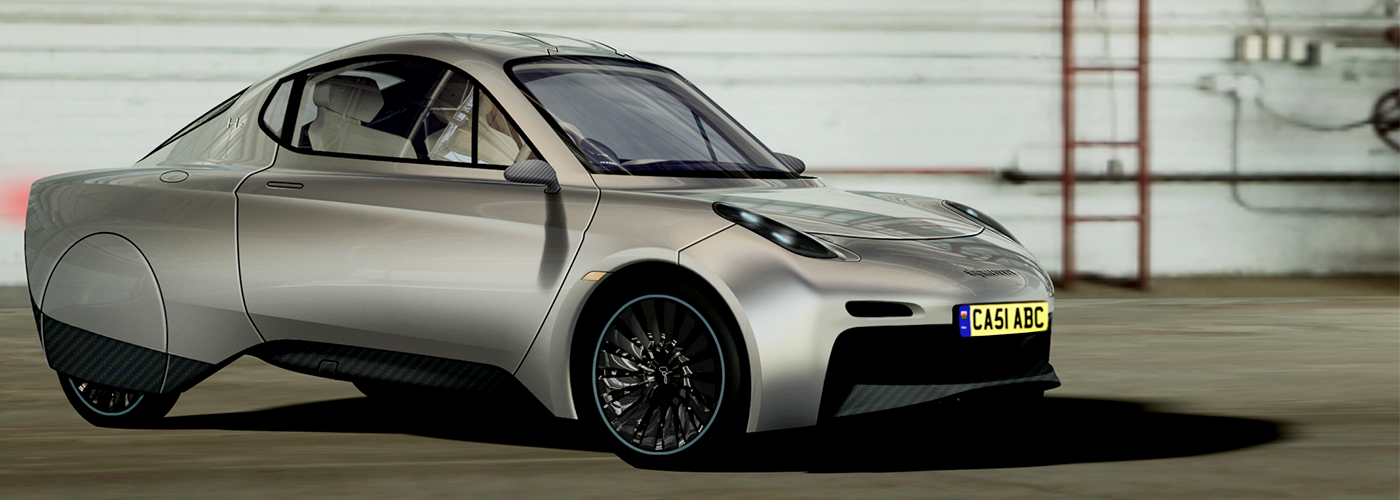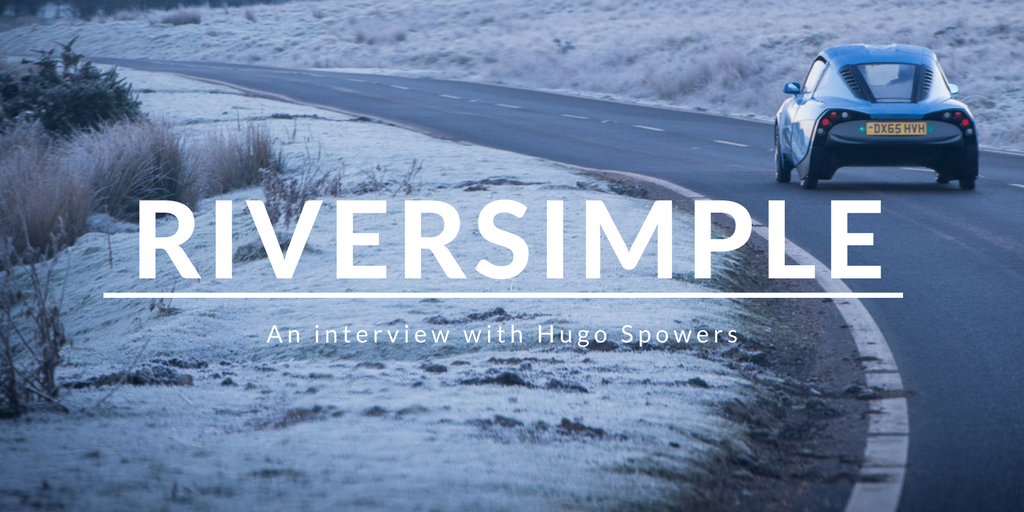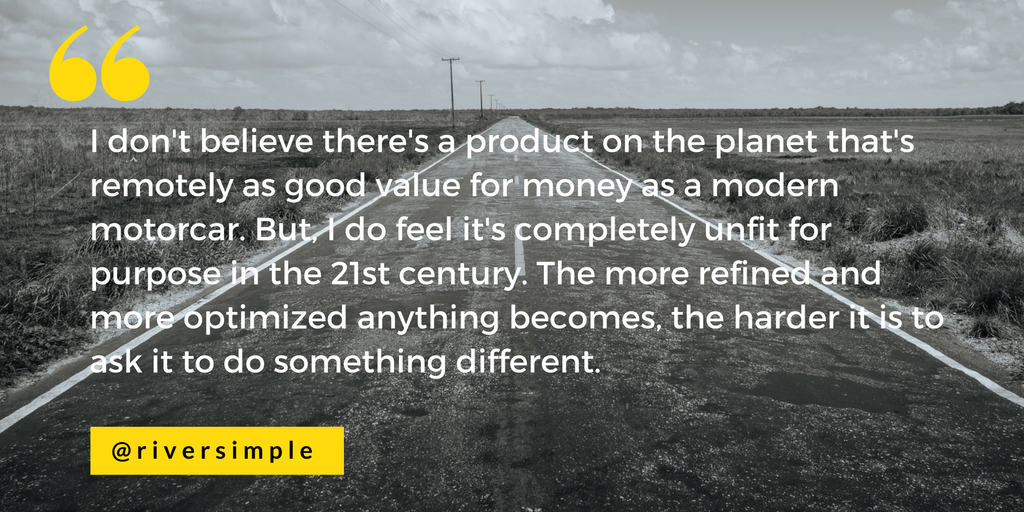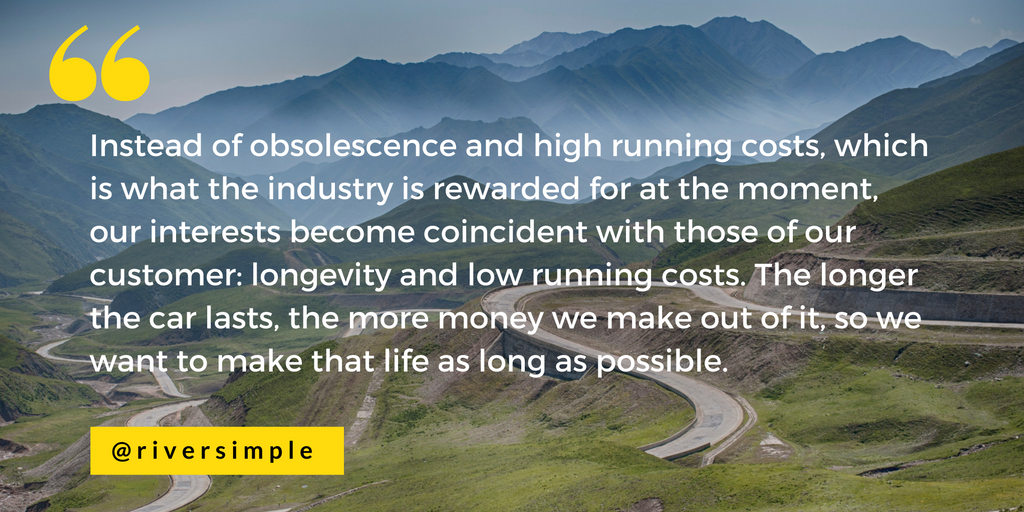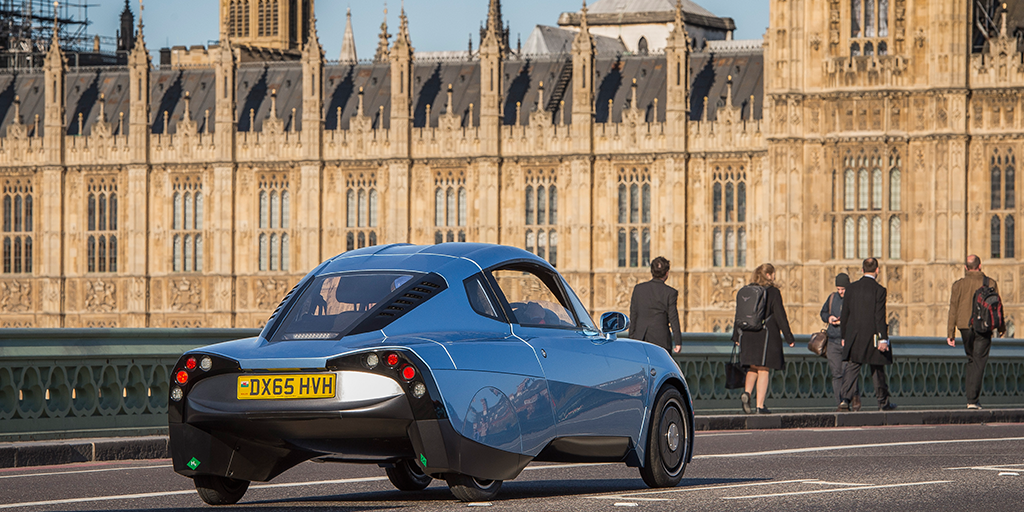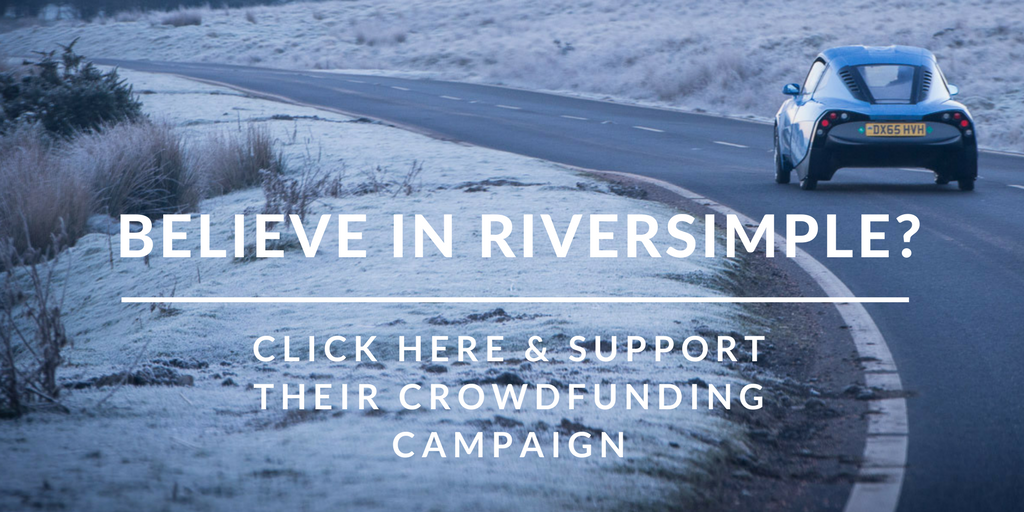Transportation accounts for over 14 percent of global greenhouse gas emissions. Cars alone burn a massive portion of these fossil fuels. Additionally, the global auto industry projects to manufacture over 107 million vehicles in 2020.
But what if cars didn’t have to run on petroleum-based fuel, and the auto industry didn’t have to continue dumping resource-intensive products on the market? After over 15 years of tireless engineering and ingenuity, U.K.-based company Riversimple launched its prototype in February 2016.
The purpose of the company is to pursue systematically the elimination of environmental impact of personal transport. Tweet This Quote
The “Rasa” is a sleek, ice blue, carbon-fiber car that sits two passengers. It’s powered by a hydrogen fuel cell instead of fossil fuels, providing a range of 300 miles and weighing less than half the average compact car. You may have seen it gracefully weaving through the streets of London. And emissions? Zero.
It’s not only about the sexy, environmentally conscious car; it’s also the company’s entirely new business model. Instead of selling cars, Riversimple will retain ownership and offer mobility as a service. One monthly fee covers everything. In the long-term, they see a world of distributed manufacturing, where small towns everywhere can employ hundreds to spawn local industry.
Unreasonable sat down with Founder and CEO, Hugo Spowers, at his workshop in Llandrindod Wells, Wales, to discuss racing cars and the risk and struggle involved in sparking a sustainable mobility revolution.
The first thing I wanted to ask you, Hugo, is what you were like as a child?
H: What I was like as a child? Gosh, what was I like as a child? Well, I was more interested in nature than anything else. So studying, identifying, collecting anything to do with nature, really, was my main thing before I caught the motor racing disease at about age 15 or so.
And what was it that attracted you to racing? What was it about racing cars?
H: As a sport, I always describe good driving as being sort of like dancing ballet on the tightrope. To really ring the maximum amount out of a car, you absolutely have to be on the very, very edge. People think of driving fast as being a really aggressive thing. But if you want to get anywhere close to that 100 percent, you’ve got to become incredibly fine and delicate. Trying to string that together, corner after corner, lap after lap, has such finesse to it when it’s done well.
What got you so interested in designing cars?
H: I suppose I got interested in the design of cars because of motor racing. Trying to think back now … I think I sort of enjoyed the whole pioneering saga of early motorsport and land speed records and the human story before I was really interested in the vehicle technology, but that followed pretty soon thereafter. So basically, I wanted to design racing cars and drive racing cars. But, I wanted to drive the cars that I designed.
I also think it’s a very complex and knotty problem, designing a car to go around multiple different corners, fast and slow and in all sorts of conditions – and beat all the other cars at that. It’s a very complex design challenge, but the motivation is utterly single-minded. It’s not like designing a road car, where you’ve got to deal with the accounting department and the marketing department that want more chrome strips on the side, things like that. It’s a pure objective – a very, very pure engineering exercise.
In University, what did you study that taught you how to design cars?
H: Oh, engineering. It was engineering science at Oxford and highly theoretical, really closer to physics than engineering in some respects. But what it did do was give me the fundamentals so that I could pick up a textbook on any subject and understand it.
I did purposely try and avoid anything to do with electricity or electronics because you didn’t need them for designing racing cars in the 70s. Now, I wish I’d paid a bit more attention because the car’s riddled with electricity and electronics. But luckily there are some other people who know more about it than I do.
When did you start racing?
H: I didn’t start racing until just after University, when I was 22 or 23. I started working in the motor racing business, and then I built my first racing car when I was 26. That attracted an investor who suggested opening a business together to produce more of the racing cars I was designing.
After a few years of that, I went on my own with a lot of work to supplement the motor racing activity, which is a reliable way of losing money. I set up a business, and in the same workshops I was restoring race cars for wealthy customers. That funded the first business, but it gradually switched over because you tend to do the things that are bringing in the bacon. I had some really fantastic cars through the workshops over the years.
Ultimately, we’ve got to completely decouple from fossil fuels and power our cars from renewable energy. Tweet This Quote
And you were actually racing the cars you built, right?
H: I was racing them in Formula 4 and up to Formula 3. I wanted to race them much more than I did, but I never had enough money to do it full time.
By that stage, though, my interest was slightly waning in motor sport because it’s all so regulated to prevent any significant innovation. It’s always held up as being the forefront of automotive engineering, but in fact it’s so governed by TV viewing numbers and things like that, the last thing they want is a car that is significantly better than anybody else. It doesn’t make for an exciting race series. The paradox is that these rules are so tight that it’s very difficult to make any substantive innovations. So the only way of winning is by incremental optimization. That, of course, is massively more expensive than making big steps. It also takes the challenge out, and it gets more and more out of reach financially.
The real killer reason was that I used to defend my involvement in motorsport and my interest in the environment on the basis that motorsports are the quickest and cheapest ways to make cars more efficient, which I still believe is true. But I reached the conclusion that we need to get rid of combustion engines all together, so prolonging the tenure of the combustion engine didn’t really stack up any longer.
When I think of a race car driver, I think of someone who’s really risky, daring, and bold. What’s your philosophy on risk?
H: I mean, certainly in motor racing, it’s obviously dangerous, or it used to be dangerous anyway. I certainly like doing dangerous things, but I wouldn’t classify myself as an adrenaline junkie. I do like pushing the outside of the envelope, if you like, and I think that’s what gets me out of bed in the morning. I’m not very interested in routine, or in engineering terms, in optimizing things. I’m interested in the next frontier.
Well that’s what you’re doing now, taking a different path. And the auto industry is not the easiest game to play. So I’m curious, what is it about you or the work that you do that makes you feel like it’s possible to take on this giant of an industry?
H: Well, the automotive world is now so mature, I mean, it’s brilliant at what it does. I don’t believe there’s a product on the planet that’s remotely as good value for money as a modern motorcar. But, I do feel it’s completely unfit for purpose in the 21st century. The more refined and more optimized anything becomes, the harder it is to ask it to do something different.
It’s just smart business to try and redesign our business models to reward resource efficiency rather than resource consumption. Tweet This Quote
There really are very few advantages to being a startup, but the really significant one that’s not to be underestimated is having a clean sheet of paper. We wouldn’t pretend for one moment that this car is highly optimized at a component level. There’s enormous room for improvement. But what we have done is optimize at the whole system level, and we’ve made a complete step-change.
What’s critical for us now is that we make fuel efficiency profitable. That’s why we need a change in business model – to enable us to commercially justify building the technology that we know is possible and what society needs, but doesn’t make any sense in the existing auto industry. Because of that, we feel we have an opportunity, unilaterally, to pursue a completely different path because we’ve made it into a source of competitive advantage.
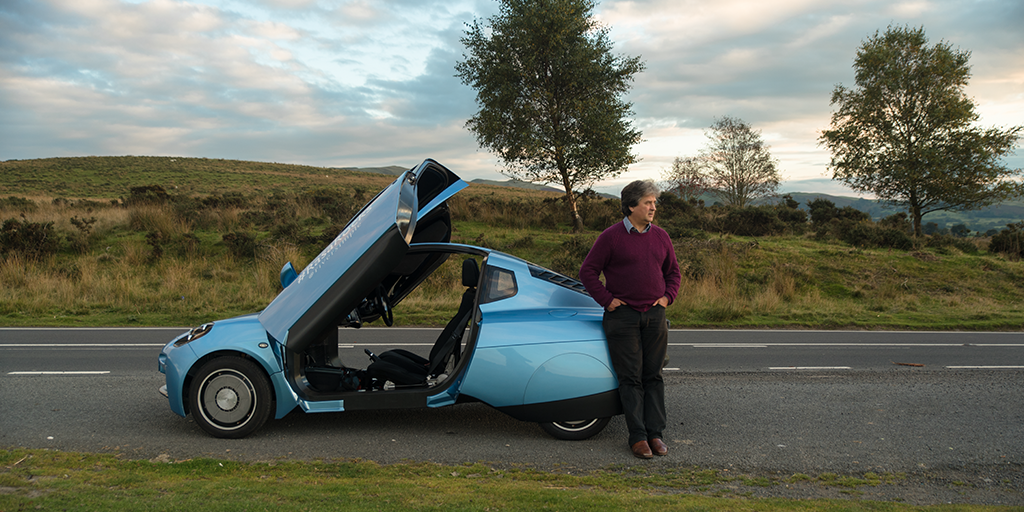
Hugo pictured with the Rasa prototype. Photo by Caitlin Kleiboer.
Why do you think the world needs this sort of step-change in the auto industry?
H: Clearly, there’ s a climate change issue. Although combustion engine cars are getting incrementally more efficient under regulatory pressure, there’s a limit to how far they can go. We’ve got to completely decouple from fossil fuels. Ultimately, we’ve got to power our cars from renewable energy sources.
We live in a very profligate way in energy terms. So, we need a step-change in efficiency, but also we need a step-change in the way we do business because if you sell cars, then you make more money by selling more cars. You’re rewarded directly for maximizing resource throughput. It’s just smart business to try and redesign our business models to reward resource efficiency rather than resource consumption.
Do you think of yourself as a car company?
H: At the moment, if we tried to compete with the auto-industry in their game, I completely accept we wouldn’t have a hope of surviving. But we don’t actually see ourselves as competing directly in the market for selling cars. We’re doing something completely different. We’re in the business of providing mobility, so it’s a different proposition to the customer in a different market niche.
We don’t actually see ourselves as competing directly in the market for selling cars. We’re doing something completely different. Tweet This Quote
So how does that translate into how you do business?
H: So instead of selling a car as a product, we are selling mobility as a service. It will be rather like a mobile phone. We will sell a performance contract of typically one to three years with a monthly direct debit – and that covers all your costs. It includes not just the car and the maintenance, but also insurance, and critically, it includes the fuel.
Instead of obsolescence and high running costs, which is what the industry is rewarded for at the moment, our interests become coincident with those of our customer, i.e. longevity and low running costs. And the longer the car lasts, the more money we make out of it. We capture 100 percent of the revenues generated by a car throughout its life, so we want to make that life as long as possible.
There’s also a lot of embodied carbon in the car, so the longer we keep that car out there running and lower the carbon intensity of the actual asset itself, the more efficient it is – and the more money we make. So we really invest heavily in energy efficiency because we are the ones who get the savings.
So bringing it back to that cell phone example … it’s like if you bought a cell phone and every once and awhile you sent it in and got a complete upgrade, complete service all cleaned and brought it back and it’s like brand new. Is that sort of how it works?
H: So as the car gets older through its life, we will do upgrades. Things like software upgrades are a marginal cost of zero, really, and they can have a huge impact on the energy efficiency of the car. But there will also be upgrades in terms of fuel cells – the fuel cell won’t last as long as the life of the car.
There really are very few advantages to being a startup, but the really significant one that’s not to be underestimated is having a clean sheet of paper. Tweet This Quote
But as the car gets older, of course it will look older. When it’s seven years old, for example, we won’t be doing annual facelifts or anything like that. But there’s demonstrably a market for cars that aren’t the latest, flashiest model. The average car life in the UK is 13 years. After about seven years, we think, people really aren’t buying for status. They’re buying for price, functionality, and reliability.
One also has to bear in mind that there are no moving parts in our car apart from the wheels. So there’s no metal-to-metal contact, no wear, no lubricants or oil changes. There’s no earthly reason why we can’t get a life longer than 15 years.
And how would customers then get fuel for the car, and how do they utilize the full range of service?
H: Well, as with all disruptive technologies, we’re coming to market initially where the weaknesses of the new technology don’t matter so much – these are the cost and the power of fuel cells, and the fact that there’s no hydrogen infrastructure yet.
But, there are a lot of people who have a car just for local use. If you put a single filling station into a large town or a small city, anybody who has a reason to come into that city from the surrounding area once a week is a potential customer. That’s a big market. If we put in one filling station and 50 cars, for example, that filling station quickly has 50 captive customers.
If you bring cars to market that are capable of intercity motorway distances, then you need a nationwide network of infrastructure before you’ve got a commercial market. That is a huge chicken-and-egg problem. We think that by focusing on the local car segment (which is a segment that the industry doesn’t make a car specifically for at the moment), then that unlocks the commercial market at small increments, and we can scale up – one filling station at a time.
What have been the struggles?
H: Oh gosh, I mean it has been a bit of a rollercoaster bringing this technology forward this far. We’ve been told many times over the years that we can’t do it like this. We have had a lot of pressure over the years just to do one thing. Just build the car, and worry about all your other fancy ideas later. But when you’re going for a step-change, that’s absolutely catastrophic.
You’ve got to listen to all the criticism, but you also have to be stubborn and stick to your view. Tweet This Quote
We’re inured to thinking that doing multiple things simultaneously is risky. But as one investor has said to us many times now, there’s nowhere better understood than the auto industry. It’s studied to death, but there’s nowhere riskier to put your money. So clearly, uncertainty and risk are not quite the same thing. But it’s difficult culturally, particularly in the Western tradition, to understand why multiple changes can actually be less risky.
It’s getting easier, though, and we’re proving it more and more. We’ve now got a car on the public road, there’s more momentum, and the world is catching up with us. We’re a long way ahead of the curve, and that’s a very uncomfortable place to be. When you’re a little bit ahead of the curve, that’s much better and much easier for people to glimpse the logic behind what we’re talking about.
But it has been quite a struggle. You’ve got to listen to all the criticism, but you also have to be stubborn and stick to your view. Unfortunately, those two characteristics are at opposite ends of the personality spectrum. I’m much better at being stubborn than listening, but I’ve had to force myself to get better.
So I know you and your wife, Fiona, work quite closely in building Riversimple. What’s it like working together on a startup that’s tackling such a hard problem?
H: My wife, Fiona, has been incredibly supportive for a very long time. She supported the family for years without me generating an income, and there were many years before I actually earned any money out of this. But it’s more than that. She’s been pretty engaged with all the development of the strategies around Riversimple. She was head of strategic planning for a global communications company, and her job title was Head of Disruption. As you can tell, disruption is not far from what we’re working on.
How do you guys work together? What are her strengths and what are yours?
H: Well, her strength is her patience. She’s also a fantastic sounding board because she’s completely on the same wavelength as me, understanding the opportunities in what we’re doing and looking for creative synergies across the various aspects of the business. As you can imagine, there are good times and bad times, and she’s been very, very robust at keeping a balanced perspective when things go badly wrong.
We spoke once at dinner about the similarities and differences between what you’re doing now versus racing cars. You mentioned that it’s harder to be an entrepreneur because it’s just a constant uphill battle as opposed to a quick win. Tell me more about that.
H: Well, the real parallel, I think, is pushing the boundaries of what’s possible and being utterly convinced that it’s possible. In adventure sports, I never thought I was going to hurt myself, but you’d have to be quite short on imagination not to be frightened. There’s quite a lot of composure required to keep carrying on because there’s a lot of reasons to doubt that you’re doing the right thing. It’s obviously completely different if you’re talking about physical danger or business risk. But the issue is the same – you have to have confidence in your own judgment.
Revolutionizing the car industry is a tall order. What will success look like for you?
H: I think for me … I don’t know, I mean there are so many stages along the way. There have been really great milestones: proving technically in a test cell, proving a car that people can drive around that looks sort of normal, and getting a car onto public roads. But it’s such a big mountain; I can’t honestly say there are many great moments where I’ve sat back without an eye on the next problem.
I don’t think I’d be the person to run this company when it gets to revenue generating stages. Once it’s in any way stabilized, I would very much like to think that we’re building a company where nobody’s indispensable. The purpose of the company is to pursue, systematically, the elimination of environmental impact of personal transport. We are purposely designing the company so that it’s not dependent on an individual holding the company to that purpose. So possibly the biggest milestone of all is to prove that – to be able to step back.
This company participated in Unreasonable Impact created with Barclays, the world’s first multi-year partnership focused on scaling up entrepreneurial solutions that will help employ thousands while solving some of our most pressing societal challenges.


